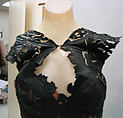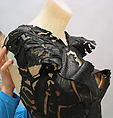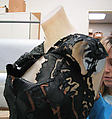Dress
Designer Roberto Cavalli Italian
Not on view
Roberto Cavalli first found recognition in the global fashion market with his Patchwork collection of 1971. The Patchwork garments were exhibited at the famed White Room, or La Sala Bianca, of the Palazzo Pitti in Florence in 1972. Italian couturiers and couture customers of the early 1970s were shocked by Cavalli's work, snubbing the calico construction and dismissing the weathered denims as workingman's fabric. However, few could argue with the designer's intuitive convergence of handcrafted ornamentation and haute couture tailoring. After photographs were published of Brigitte Bardot wearing a Cavalli printed jacket in Saint-Tropez, an appreciation for the designer's love of street artistry became infused into 1970s high fashion and Cavalli's clothing became a staple of the wardrobes of young, wealthy Europeans. His sandblasted jeans, photographically printed denims, laser-cut and embroidered leathers, and brightly dyed and pieced furs finally achieved critical acclaim in the late 1970s and early '80s.
Today, Roberto Cavalli's name is synonymous with fine leather processing. The designer's signature use of calfskin (traditionally employed in glove design) has allowed him to manipulate animal skins as if they were silk. This design, from Cavalli's spring/summer 2003 collection, toys with black leather biker culture and a tattooist's line, yet exhibits a sculptor's grace with precise laser-cut edges and an elegant drape, unarguably implying the wealth and status of its wearer.
This image cannot be enlarged, viewed at full screen, or downloaded.
This artwork is meant to be viewed from right to left. Scroll left to view more.







